ssis 列转换
This article explores the Term extraction transformation in SSIS and its usage scenario.
本文探讨了SSIS中的术语提取转换及其使用方案。
介绍 (Introduction)
Developers face new requirements and challenges each day. They write complex codes to fulfill these requirements. Recently my developer friend approached me for text mining. The requirement is to extract the following information from text stored in the SQL table.
开发人员每天都面临着新的要求和挑战。 他们编写复杂的代码来满足这些要求。 最近,我的开发人员朋友联系我进行文本挖掘。 要求是从SQL表中存储的文本中提取以下信息。
- Noun 名词
- Noun phrases 名词短语
- Nouns and noun phrases 名词和名词短语
To explain this situation, create the following SQL table.
为了解释这种情况,请创建以下SQL表。
USE [SQLShackDemo]
GO
SET ANSI_NULLS ON
GO
SET QUOTED_IDENTIFIER ON
GO
CREATE TABLE [dbo].[articles](
[Article List] [nvarchar](100) NOT NULL
) ON [PRIMARY]
GO
In this table, I inserted my published article titles on SQLShack (total 137) using the following query in the appendix.
在此表中,我使用附录中的以下查询在SQLShack上插入了已发表的文章标题(总计137)。
Data in the SQL table looks like below.
SQL表中的数据如下所示。
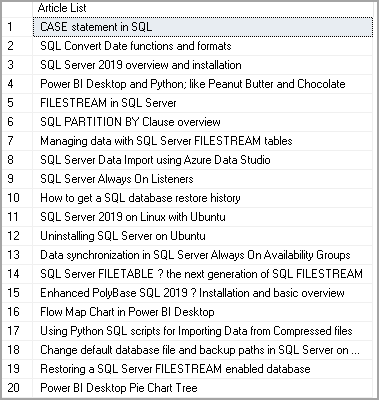
In this article, we will explore how to extract the required information using the SSIS package transformations.
在本文中,我们将探讨如何使用SSIS包转换来提取所需的信息。
先决条件 (Prerequisites)
- SSIS articles on SQLShack for this SSIS文章
- Editions and supported features 版本和受支持功能的更多信息
SSIS中的术语提取转换概述 (Overview of Term Extraction Transformation in SSIS)
We use the Term Extraction Transformation for extracting terms from the source data. We can extract four kinds of data from this transformation.
我们使用术语提取转换从源数据中提取术语。 我们可以从此转换中提取四种数据。
- Nouns Only: It extracts a single-word noun, for example, Hat, Bottle, Table, and Car 仅名词:提取单个名词,例如“帽子”,“瓶子”,“桌子”和“汽车”
- Noun Phrases: Noun Phrases is a combination of Noun and Noun or an adjective. For Examples: Red Car, Hot bottle 名词短语:名词短语是名词和名词或形容词的组合。 例如:红色汽车,热水壶
- Nouns and Noun Phrases: It extracts both the Nouns and Noun Phrases in this option 名词和名词短语:在此选项中同时提取名词和名词短语
关于SSIS中术语提取转换的几个重要事实 (Few important facts about the Term Extraction Transformation in SSIS)
- We can extract information from English Text only. It uses its English dictionary for this 我们只能从英文文本中提取信息。 为此,它使用英语词典
It does not extract the articles and pronouns. For example, the transformation fetches Car from the following words
它不提取文章和代词。 例如,转换从以下单词中获取Car
The Car, Your Car, That Car
汽车 , 你的车 , 那辆车
-
- Frequency: It represents several occurrences of a term in the text. It is a real number such as 1.0, 2.0 频率:它表示文本中某个术语的多次出现。 它是一个实数,例如1.0、2.0
-
TF: Term Frequency: It shows the frequency of a term in the text
TF:术语频率:它在文本中显示术语的频率
TF(t) = (Frequency of a term in the text) / (Total number of words in the text).
TF(t)=(文本中术语的频率)/(文本中单词的总数)。
IDF: Inverse Document Frequency: It uses a mathematics log function to calculate the inverse document frequency
IDF:反向文档频率:它使用数学对数函数来计算反向文档频率
IDF(t) = log_e(Total number of rows / Number of rows having term in it).
IDF(t)= log_e(总行数/包含项的行数)。
Suppose a document contains 100 words, and the SQL appears three times.
假设一个文档包含100个单词,并且SQL出现3次。
TF: Term Frequency: for the term SQL, the TF value is 3/100=0.03
TF:术语频率:对于SQL术语,TF值为3/100 = 0.03
IDF: Inverse Document Frequency: Suppose we have 200 rows in the SQL table and word SQL appears in 50 documents.
IDF:反向文档频率:假设我们在SQL表中有200行,而SQL单词出现在50个文档中。
We calculate the value for the IDF using the following function.
我们使用以下函数计算IDF的值。
Log(200/50)= 1.39
对数(200/50)= 1.39
Therefore, the value of TDIDF is 0.03*1.39 = 0.0417
因此,TDIDF的值为0.03 * 1.39 = 0.0417
The Term Extraction Transformation in SSIS works with the text column having data type as DT_WSTR or DT_NTEXT. If we have text data in other columns, we can convert them to the appropriate format and use the transformation
SSIS中的术语提取转换适用于数据类型为DT_WSTR或DT_NTEXT的文本列。 如果我们在其他列中有文本数据,则可以将它们转换为适当的格式并使用转换
SSIS中术语提取转换的术语提取 (Extraction of Terms for Term Extraction Transformation in SSIS)
SSIS Term Extraction splits the text into smaller words. It considers the following points for the term extraction.
SSIS术语提取将文本分成较小的单词。 对于术语提取,它考虑了以下几点。
- It uses the spaces, line breaks and word terminators such as Dot (.), Comma (,) and question mark (?) 它使用空格,换行符和单词终止符,例如点(。),逗号(,)和问号(?)
- We can have words with a hyphen or underscore in the text such as cross-region, read-only. Term extractions consider these as a single word 我们可以在文本中使用带连字符或下划线的单词,例如跨区域,只读。 术语提取将它们视为一个词
- It ignores the special characters such as @,#. For example, it considers #SQL as SQL 它忽略诸如@,#之类的特殊字符。 例如,它将#SQL视为SQL
- It does not break the word using the apostrophe. For example, it considers word Children’s as Children 它不会使用撇号将单词打断。 例如,它将“儿童”一词视为“儿童”
- It splits the email address, postal address and time expressions into separate words 它将电子邮件地址,邮政地址和时间表达分成单独的单词
- It ignores acronyms in a word and considers it as a single word. For example, it considers X.Y.Z as XYZ 它忽略单词中的首字母缩写词,并将其视为一个单词。 例如,它将XYZ视为XYZ
-
- Cars become Car 汽车成为汽车
- Women become Woman 女人成为女人
- Babies become Baby 婴儿变成婴儿
- Tooth becomes Teeth 牙齿变成牙齿
-
- It normalizes the capital letters into non-capitalized characters 它将大写字母标准化为非大写字母
- Word Car, CAR and car all get converts to car 单词Car,CAR和car都可以转换为car
- Ram drives car or Ram drives a CAR are similar for the text extraction Ram驱动器的汽车或Ram驱动器的汽车类似于文本提取
- If we use the case sensitive search, the extraction considers word car and Car as separate words 如果我们使用区分大小写的搜索,则提取会将单词car和Car视为单独的单词
创建用于SSIS中术语提取转换的SSIS包 (Create an SSIS package for Term Extraction Transformation in SSIS)
In the Data Tools for Visual Studio, create an integration package and configure a data flow task. This data flow task selects the data from the source table we created earlier.
在用于Visual Studio的数据工具中,创建一个集成包并配置数据流任务。 该数据流任务从我们之前创建的源表中选择数据。
Once we have configured the data flow task for the source table, you get the following package configuration.
为源表配置数据流任务后,您将获得以下程序包配置。
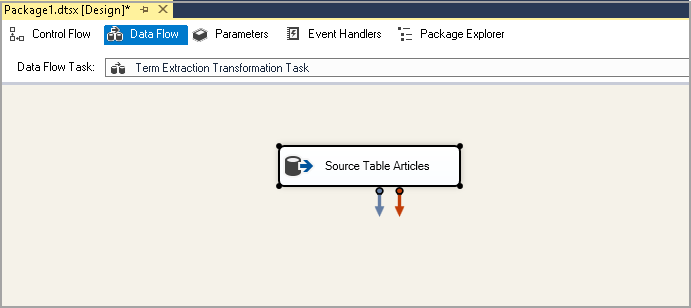
Drag the Term Extraction from the SSIS Toolbox and connect it with the source table using the green arrow.
从SSIS工具箱中拖动术语提取,并使用绿色箭头将其与源表连接。
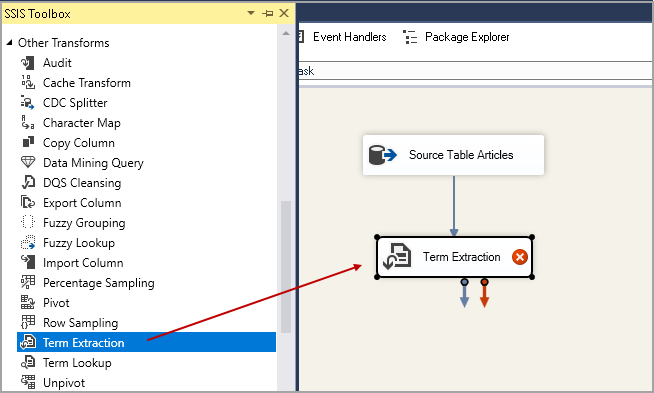
Double-click on the term extractions, and it opens the term extraction transformation editor.
双击术语提取,它将打开术语提取转换编辑器。
In the first tab, Term Extraction, select the input columns. It shows the available columns from the configured data source. Put a check on the input column.
在第一个选项卡术语提取中 ,选择输入列。 它显示了已配置数据源中的可用列。 在输入列上打勾。
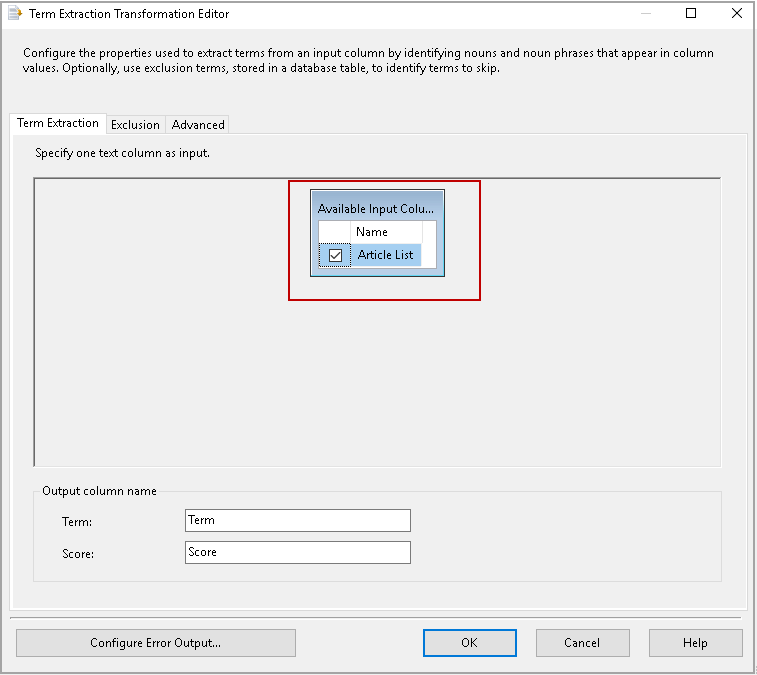
It gives the two output columns Term and Score.
它提供了两个输出列Term和Score。
- Term: It extracts terms such as Nouns from the text 术语:从文本中提取名词等术语
- Score: In this column, we get the frequency of a term in the text 分数:在此列中,我们获得文本中术语的出现频率
We can change the name of these columns as well. Type the new names in the text box, as shown below.
我们也可以更改这些列的名称。 在文本框中键入新名称,如下所示。
We will skip the configuration in the tab Exclusion as of now. Click on the Advanced tab, and it opens the following configurations.
到目前为止,我们将跳过“ 排除 ”选项卡中的配置。 单击“ 高级”选项卡,它将打开以下配置。
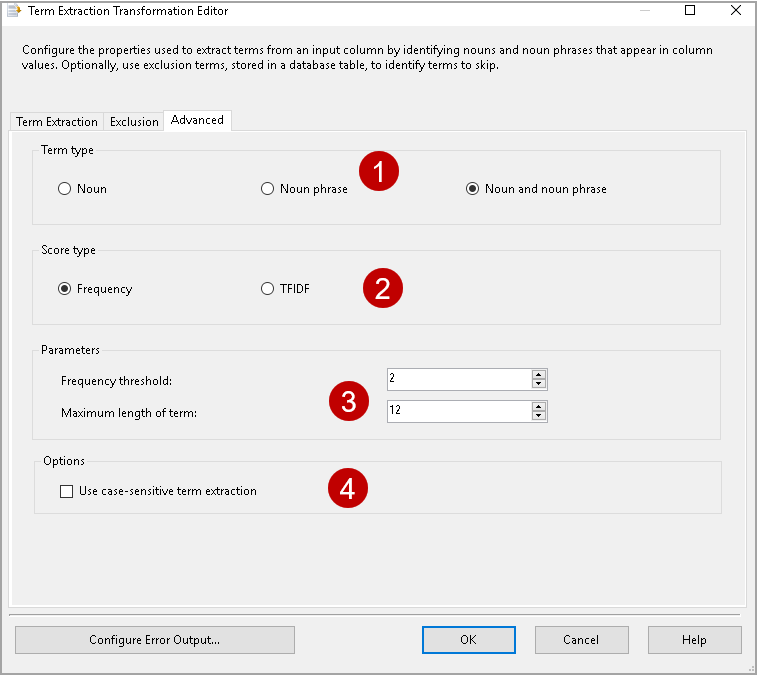
We have following configuration available in the advanced section.
我们在高级部分提供以下配置。
-
- Noun 名词
- Noun phrase 名词短语
- Noun and noun phrase 名词和名词短语
- Scope type: As defined earlier, we can select scope type as Frequency or TFIDF 范围类型:如前所述,我们可以选择范围类型为“频率”或“ TFIDF”
- Frequency threshold: By default, it shows the frequency threshold 2 in the screenshot. It shows that a particular term should repeat a minimum two times. If it appears less than two times, it ignores the term 频率阈值:默认情况下,它在屏幕快照中显示频率阈值2。 它表明一个特定的术语至少应重复两次。 如果出现少于两次,则忽略该术语
- The maximum length of item: in this column, we define the maximum length of a word or phrase. By default, its value is 12. It is available for Noun phrase, Noun and noun phrase term types 项目的最大长度:在此列中,我们定义单词或短语的最大长度。 默认情况下,其值为12。它适用于名词短语,名词和名词短语术语类型
- Use case-sensitive term extraction: We can perform a case-sensitive term extraction using this option 使用区分大小写的术语提取:我们可以使用此选项执行区分大小写的术语提取
Let’s use the following options for term extractions.
让我们使用以下选项进行术语提取。
Click OK, and we can see the following SSIS data flow configuration. You see a warning message that rows sent to the error will be lost. We have not configured the error output, and we can ignore this warning message.
单击“确定”,我们可以看到以下SSIS数据流配置。 您会看到一条警告消息,指出发送给该错误的行将丢失。 我们尚未配置错误输出,我们可以忽略此警告消息。
If we do not want this warning message, double click on term extraction and click on Configure Error Output.
如果我们不希望此警告消息,请双击术语提取,然后单击“配置错误输出”。
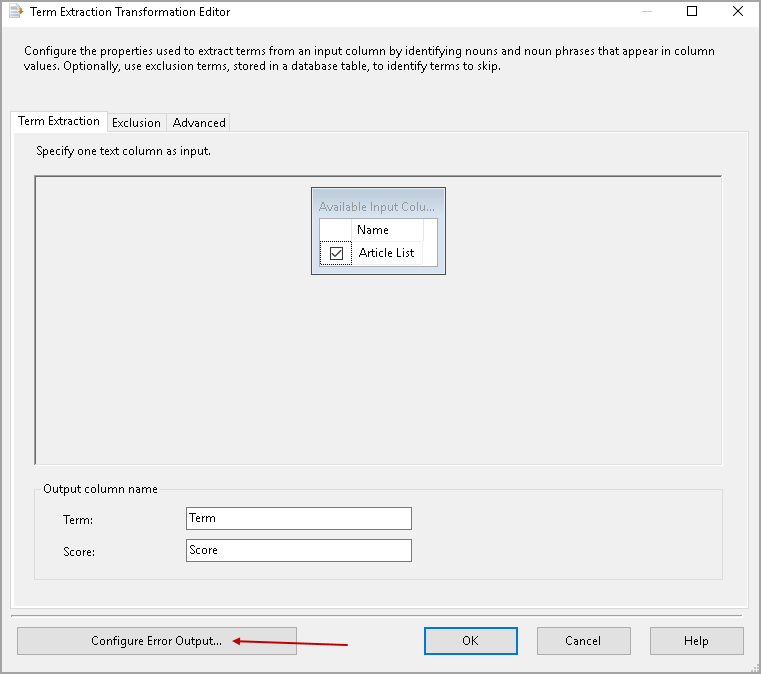
In the Error column, select Ignore failure option as shown below.
在“ 错误”列中,选择“ 忽略故障”选项,如下所示。
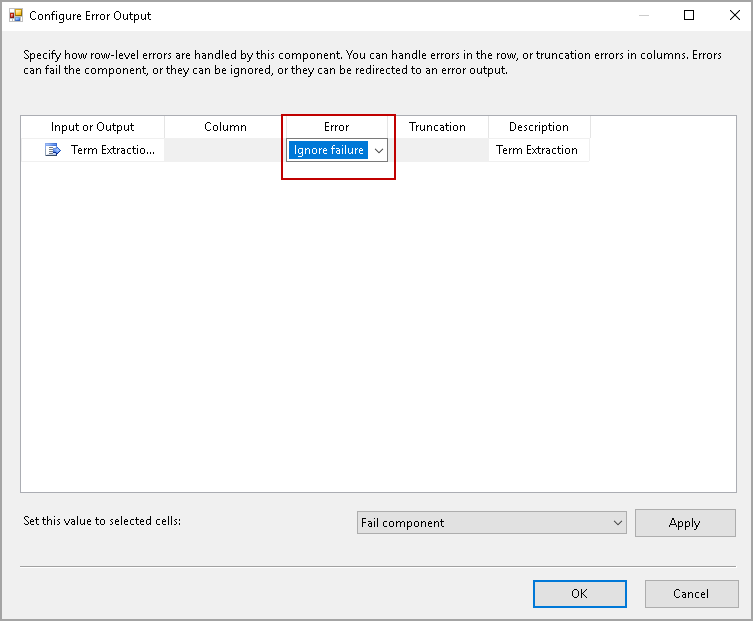
We do not see a warning message for the term extraction.
对于术语提取,我们没有看到警告消息。
Let’s add an OLE DB destination to store the output in a SQL table. You can use an existing table or create a new table.
让我们添加一个OLE DB目标以将输出存储在SQL表中。 您可以使用现有表或创建新表。
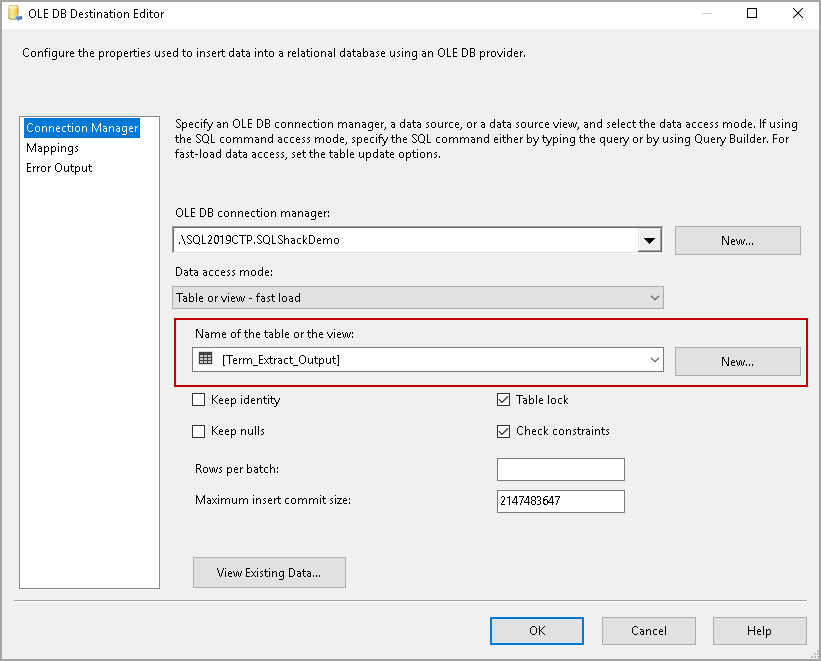
In the mapping, verify the mapping between source and destination tables.
在映射中,验证源表和目标表之间的映射。
The Term Extraction Transformation in SSIS configuration is now complete as shown in the following image.
SSIS配置中的术语提取转换现已完成,如下图所示。
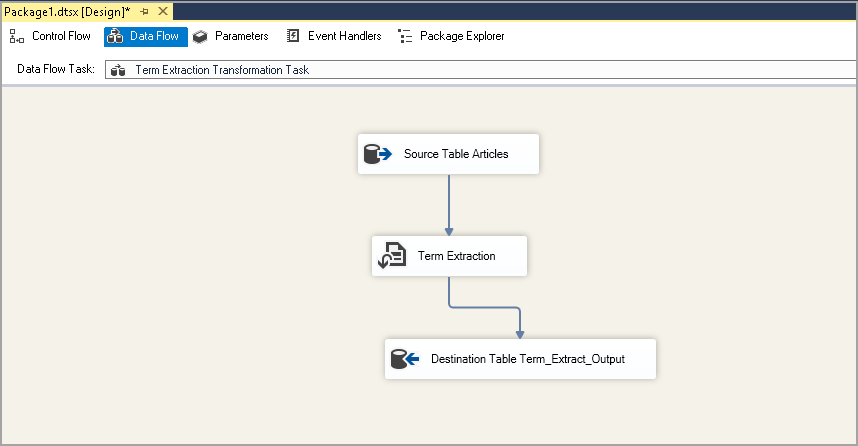
Execute the SSIS package. In the following screenshot, we can see the package executed successfully.
执行SSIS包。 在以下屏幕截图中,我们可以看到程序包已成功执行。
Let’s check the records in the destination table. We can see the extracted Noun terms and their frequency.
让我们检查目标表中的记录。 我们可以看到提取的名词项及其频率。
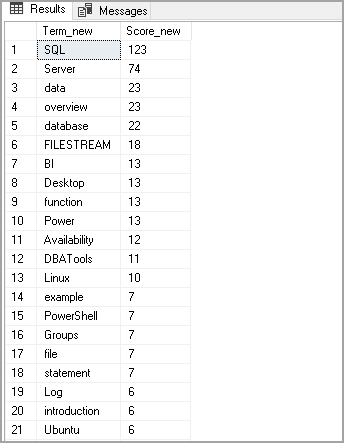
Now, change the scope type as TFIDF for the Noun.
现在,将名词的作用域类型更改为TFIDF。
Execute the SSIS package, and we get the following output. You can notice the difference in the terms and their scores as compared to the frequency scope type.
执行SSIS包,我们得到以下输出。 您会注意到与频率范围类型相比,术语及其得分有所不同。
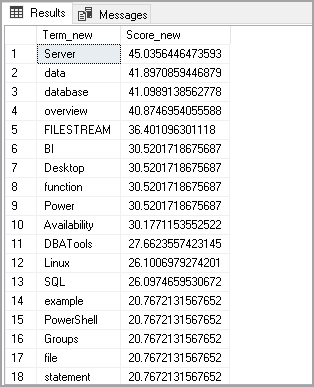
Let’s modify the term extractions for
让我们修改术语“提取”
- Score type: Frequency 得分类型:频率
- Term type: Noun and noun phase 术语类型:名词和名词阶段
It extracts 25 rows from the source table and inserts into the destination table.
它从源表中提取25行,并插入到目标表中。
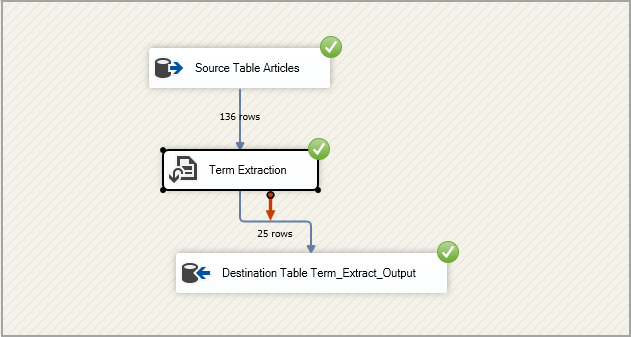
In the output, you can see we get the noun phrase and noun. Previously, we get only a single word noun.
在输出中,您可以看到我们得到了名词短语和名词。 以前,我们仅获得一个单词名词。
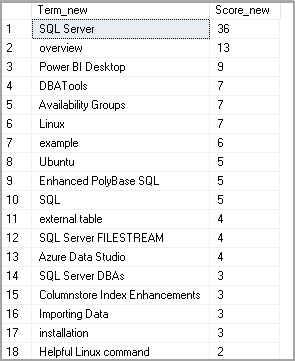
By default, term extraction transformation in SSIS is a case-insensitive activity. We can perform case-sensitive term extraction with the option Use case-sensitive term extraction.
默认情况下,SSIS中的术语提取转换是不区分大小写的活动。 我们可以使用选项区分大小写术语提取来执行区分大小写的术语提取。
- Term type: Noun 术语类型:名词
- Scope type: Frequency 范围类型:频率
- Enable case-sensitive search 启用区分大小写的搜索
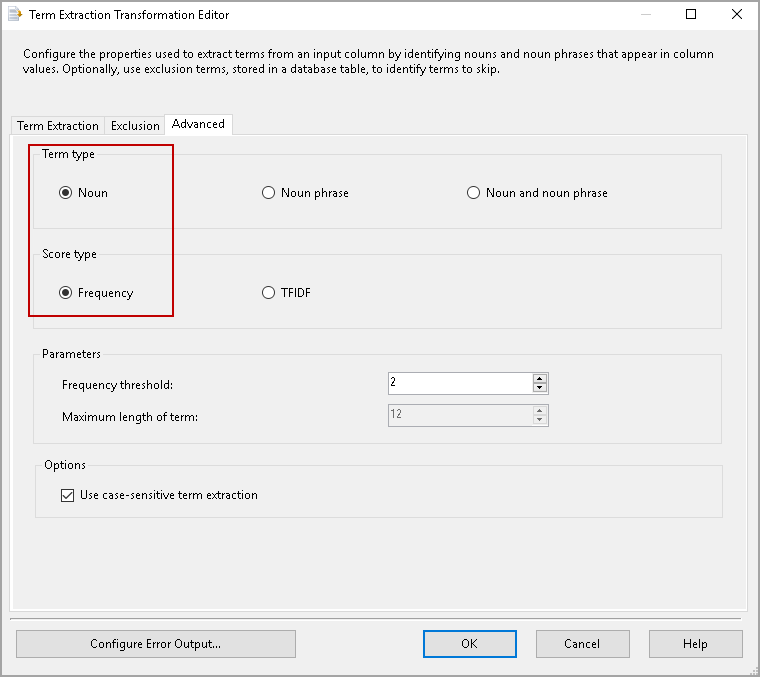
Execute the package to perform Term Extraction in SSIS and view the result in the destination table.
执行程序包以在SSIS中执行术语提取,并在目标表中查看结果。
Before executing this package, I made a few changes in the article list and changed some word from SQL to Sql. It should treat both the word separate due to a case-sensitive search.
在执行此程序包之前,我对文章列表进行了一些更改,并将一些单词从SQL更改为Sql。 由于区分大小写,因此应将两个单词分开对待。
In the output, you can notice both terms are different, and we get the frequency for both terms separately.
在输出中,您会注意到两个术语都不同,并且我们分别获得了两个术语的频率。

Previously, we ignored the configuration in the Exclusion tab. We can specify the terms that we do not want to available in the output.
以前,我们忽略了“排除”选项卡中的配置。 我们可以指定不想在输出中使用的术语。
Create an exclusion table and insert excluded terms. For example, we do not want BI term in the output.
创建一个排除表并插入排除项。 例如,我们不希望在输出中使用BI术语。
Create table Exclusion ( excludedwords varchar(20) ) Insert into Exclusion values ('BI')In the exclusion tab, select the OLE DB connection manager and select the table from the drop-down list.
在排除选项卡中,选择OLE DB连接管理器,然后从下拉列表中选择表。
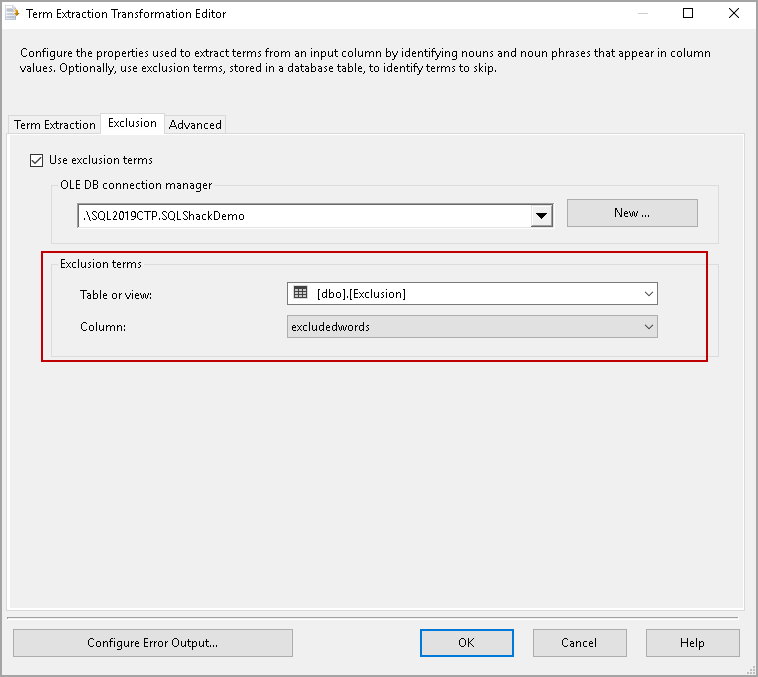
Execute the package, and you do not get the term specified in the exclusion table in the output.
执行该程序包,您不会在输出中获得排除表中指定的术语。
结论 (Conclusion)
The term extraction transformation in SSIS is a great idea to extract the relevant terms such as nouns, noun phrases from the specified text. You can also prepare a Word cloud in the Power BI Desktop after extracting information from the text. You can also use this transformation to analyze comments received from a blog post or website as well. You should explore this transformation to fulfill your requirements.
SSIS中的术语提取转换是从指定文本中提取相关术语(例如名词,名词短语)的好主意。 从文本中提取信息之后,您还可以在Power BI桌面中准备词云 。 您还可以使用此转换来分析从博客文章或网站收到的评论。 您应该探索这种转变以满足您的要求。
附录 (Appendix)
USE [SQLShackDemo] GO SET ANSI_NULLS ON GO SET QUOTED_IDENTIFIER ON GO CREATE TABLE [dbo].[articles]( [Article List] [nvarchar](100) NOT NULL ) ON [PRIMARY] GO INSERT [dbo].[articles] ([Article List]) VALUES (N'CASE statement in SQL') GO INSERT [dbo].[articles] ([Article List]) VALUES (N'SQL Convert Date functions and formats') GO INSERT [dbo].[articles] ([Article List]) VALUES (N'SQL Server 2019 overview and installation') GO INSERT [dbo].[articles] ([Article List]) VALUES (N'Power BI Desktop and Python; like Peanut Butter and Chocolate') GO INSERT [dbo].[articles] ([Article List]) VALUES (N'FILESTREAM in SQL Server') GO INSERT [dbo].[articles] ([Article List]) VALUES (N'SQL PARTITION BY Clause overview') GO INSERT [dbo].[articles] ([Article List]) VALUES (N'Managing data with SQL Server FILESTREAM tables') GO INSERT [dbo].[articles] ([Article List]) VALUES (N'SQL Server Data Import using Azure Data Studio') GO INSERT [dbo].[articles] ([Article List]) VALUES (N'SQL Server Always On Listeners') GO INSERT [dbo].[articles] ([Article List]) VALUES (N'How to get a SQL database restore history') GO INSERT [dbo].[articles] ([Article List]) VALUES (N'SQL Server 2019 on Linux with Ubuntu') GO INSERT [dbo].[articles] ([Article List]) VALUES (N'Uninstalling SQL Server on Ubuntu') GO INSERT [dbo].[articles] ([Article List]) VALUES (N'Data synchronization in SQL Server Always On Availability Groups') GO INSERT [dbo].[articles] ([Article List]) VALUES (N'SQL Server FILETABLE ? the next generation of SQL FILESTREAM') GO INSERT [dbo].[articles] ([Article List]) VALUES (N'Enhanced PolyBase SQL 2019 ? Installation and basic overview') GO INSERT [dbo].[articles] ([Article List]) VALUES (N'Flow Map Chart in Power BI Desktop') GO INSERT [dbo].[articles] ([Article List]) VALUES (N'Using Python SQL scripts for Importing Data from Compressed files') GO INSERT [dbo].[articles] ([Article List]) VALUES (N'Change default database file and backup paths in SQL Server on Linux') GO INSERT [dbo].[articles] ([Article List]) VALUES (N'Restoring a SQL Server FILESTREAM enabled database') GO INSERT [dbo].[articles] ([Article List]) VALUES (N'Power BI Desktop Pie Chart Tree') GO INSERT [dbo].[articles] ([Article List]) VALUES (N'SQL Server Profiler in Azure Data Studio') GO INSERT [dbo].[articles] ([Article List]) VALUES (N'How to create a Word Cloud generator in Power BI Desktop') GO INSERT [dbo].[articles] ([Article List]) VALUES (N'SQL Server 2019 on Linux with Ubuntu and Azure Data Studio') GO INSERT [dbo].[articles] ([Article List]) VALUES (N'SQL TRIM function') GO INSERT [dbo].[articles] ([Article List]) VALUES (N'DBATools PowerShell Module for SQL Server') GO INSERT [dbo].[articles] ([Article List]) VALUES (N'SQL truncate enhancement: Silent Data truncation in SQL Server 2019') GO INSERT [dbo].[articles] ([Article List]) VALUES (N'SQL data classification ? Add sensitivity classification in SQL Server 2019') GO INSERT [dbo].[articles] ([Article List]) VALUES (N'Improvements of Scalar User-defined function performance in SQL Server 2019') GO INSERT [dbo].[articles] ([Article List]) VALUES (N'Ask a Question feature in Power BI Desktop') GO INSERT [dbo].[articles] ([Article List]) VALUES (N'SQL Server 2019 on Linux with a Docker container on Ubuntu') GO INSERT [dbo].[articles] ([Article List]) VALUES (N'SQL Server Always On Availability Group Data Resynchronization') GO INSERT [dbo].[articles] ([Article List]) VALUES (N'"Enhanced PolyBase SQL 2019 ? External tables SQL Server, Catalog view and PushDown"') GO INSERT [dbo].[articles] ([Article List]) VALUES (N'Importing Data into SQL Server from Compressed Files') GO INSERT [dbo].[articles] ([Article List]) VALUES (N'Candlestick chart for stock data analysis in Power BI Desktop') GO INSERT [dbo].[articles] ([Article List]) VALUES (N'Graph Database features in SQL Server 2019 ? Part 1') GO INSERT [dbo].[articles] ([Article List]) VALUES (N'SQL FILESTREAM and SQL Server Full Text search') GO INSERT [dbo].[articles] ([Article List]) VALUES (N'SQL SELECT INTO statement') GO INSERT [dbo].[articles] ([Article List]) VALUES (N'SQL Union vs Union All in SQL Server') GO INSERT [dbo].[articles] ([Article List]) VALUES (N'Importing data from a PDF file in Power BI Desktop') GO INSERT [dbo].[articles] ([Article List]) VALUES (N'How to recognize corrupted SQL backup files') GO INSERT [dbo].[articles] ([Article List]) VALUES (N'SQL Restore Database using DBATools') GO INSERT [dbo].[articles] ([Article List]) VALUES (N'Static Data Masking in SSMS 18') GO INSERT [dbo].[articles] ([Article List]) VALUES (N'SQL Server CONCATENATE Operations with SQL Plus (+) and SQL CONCAT functions') GO INSERT [dbo].[articles] ([Article List]) VALUES (N'Enhanced PolyBase SQL 2019 ? External tables using t-SQL') GO INSERT [dbo].[articles] ([Article List]) VALUES (N'SQL Server FILESTREAM Database backup overview') GO INSERT [dbo].[articles] ([Article List]) VALUES (N'SQL Server Always ON Availability Group Log Backup on Secondary Replicas') GO INSERT [dbo].[articles] ([Article List]) VALUES (N'Power BI desktop Mekko Charts') GO INSERT [dbo].[articles] ([Article List]) VALUES (N'Managing Data in SQL Server FILETABLEs') GO INSERT [dbo].[articles] ([Article List]) VALUES (N'Accelerated Database Recovery; Instant Rollback and Database Recovery') GO INSERT [dbo].[articles] ([Article List]) VALUES (N'SQL Database Backups using PowerShell Module ? DBATools') GO INSERT [dbo].[articles] ([Article List]) VALUES (N'Enhanced PolyBase SQL 2019 ? External tables for Oracle DB') GO INSERT [dbo].[articles] ([Article List]) VALUES (N'"Columnstore Index Enhancements ? data compression, estimates and savings"') GO INSERT [dbo].[articles] ([Article List]) VALUES (N'Renaming Logical and Physical file names in SQL Server on Linux') GO INSERT [dbo].[articles] ([Article List]) VALUES (N'Power BI Desktop Interactive chord diagrams') GO INSERT [dbo].[articles] ([Article List]) VALUES (N'Enhanced PolyBase SQL 2019 ? MongoDB and external table') GO INSERT [dbo].[articles] ([Article List]) VALUES (N'SQL Server 2019 installation on Ubuntu without a Docker Container') GO INSERT [dbo].[articles] ([Article List]) VALUES (N'SQL Server FILESTREAM Database Corruption and Remediation') GO INSERT [dbo].[articles] ([Article List]) VALUES (N'Power BI Desktop Q&A data interaction examples') GO INSERT [dbo].[articles] ([Article List]) VALUES (N'DATEPART SQL function') GO INSERT [dbo].[articles] ([Article List]) VALUES (N'PowerShell SQL Server Validation Utility ? DBAChecks') GO INSERT [dbo].[articles] ([Article List]) VALUES (N'SQL Server FILETABLE Use Cases') GO INSERT [dbo].[articles] ([Article List]) VALUES (N'SQL ISNULL function') GO INSERT [dbo].[articles] ([Article List]) VALUES (N'SQL Code Snippets in Azure Data Studio') GO INSERT [dbo].[articles] ([Article List]) VALUES (N'Columnstore Index Enhancements ? Index stats update in clone databases') GO INSERT [dbo].[articles] ([Article List]) VALUES (N'SQL Order by Clause overview and examples') GO INSERT [dbo].[articles] ([Article List]) VALUES (N'Row Mode Memory Grant Feedback in SQL Server 2019') GO INSERT [dbo].[articles] ([Article List]) VALUES (N'DBATools PowerShell SQL Server Database Backups commands') GO INSERT [dbo].[articles] ([Article List]) VALUES (N'SQL Add Column operations') GO INSERT [dbo].[articles] ([Article List]) VALUES (N'Lightweight performance profiling in SQL Server 2019') GO INSERT [dbo].[articles] ([Article List]) VALUES (N'Importing SQL Server FILESTREAM data with SSIS packages') GO INSERT [dbo].[articles] ([Article List]) VALUES (N'Columnstore Index Enhancements ? online and offline (re)builds') GO INSERT [dbo].[articles] ([Article List]) VALUES (N'SQL Server FILESTREAM queries and Filegroups') GO INSERT [dbo].[articles] ([Article List]) VALUES (N'Changing SQL Dump file locations in SQL Server on Linux') GO INSERT [dbo].[articles] ([Article List]) VALUES (N'Get details of SQL Server Database Growth and Shrink Events') GO INSERT [dbo].[articles] ([Article List]) VALUES (N'Read Scale Availability Group in a clusterless availability group') GO INSERT [dbo].[articles] ([Article List]) VALUES (N'Hexbin Scatterplot in Power BI Desktop') GO INSERT [dbo].[articles] ([Article List]) VALUES (N'The new SQL Server 2019 function Approx_Count_Distinct') GO INSERT [dbo].[articles] ([Article List]) VALUES (N'SQL Notebooks introduction and overview') GO INSERT [dbo].[articles] ([Article List]) VALUES (N'SQL CHARINDEX') GO INSERT [dbo].[articles] ([Article List]) VALUES (N'Database Upgrade using the Query Tuning Assistant wizard in SSMS 18') GO INSERT [dbo].[articles] ([Article List]) VALUES (N'Overview of SQL IIF Statement') GO INSERT [dbo].[articles] ([Article List]) VALUES (N'Export SQL Server FILESTREAM Objects with PowerShell and SSIS') GO INSERT [dbo].[articles] ([Article List]) VALUES (N'SQL Not Equal Operator introduction and examples') GO INSERT [dbo].[articles] ([Article List]) VALUES (N'DATEADD SQL function introduction and overview') GO INSERT [dbo].[articles] ([Article List]) VALUES (N'Working with SQL Server FILESTREAM ? Adding columns and moving databases') GO INSERT [dbo].[articles] ([Article List]) VALUES (N'Power BI Desktop Pulse Charts') GO INSERT [dbo].[articles] ([Article List]) VALUES (N'Enlighten World Flag Slicer in Power BI Desktop') GO INSERT [dbo].[articles] ([Article List]) VALUES (N'Isolation levels behavior in SQL Server Always On Availability Groups') GO INSERT [dbo].[articles] ([Article List]) VALUES (N'Fix Orphan users in SQL Server using DBATools PowerShell') GO INSERT [dbo].[articles] ([Article List]) VALUES (N'SQL OUTER JOIN overview and examples') GO INSERT [dbo].[articles] ([Article List]) VALUES (N'Validate backups with SQL restore database operations using DBATools') GO INSERT [dbo].[articles] ([Article List]) VALUES (N'Renaming a SQL Server instance on Ubuntu Linux') GO INSERT [dbo].[articles] ([Article List]) VALUES (N'Viewing SQL Server FILESTREAM data with SSRS') GO INSERT [dbo].[articles] ([Article List]) VALUES (N'Transaction log backups in a SQL FILESTREAM database') GO INSERT [dbo].[articles] ([Article List]) VALUES (N'Accelerated Database Recovery and Long Running Transactions with Transaction Log Growth') GO INSERT [dbo].[articles] ([Article List]) VALUES (N'Automatic Seeding in Always On Availability Groups') GO INSERT [dbo].[articles] ([Article List]) VALUES (N'SQL Server Statistics in Always On Availability Groups') GO INSERT [dbo].[articles] ([Article List]) VALUES (N'SQL Server 2019 ? New DMF sys.dm_db_page_info') GO INSERT [dbo].[articles] ([Article List]) VALUES (N'SQL Server FILESTREAM database recovery scenarios') GO INSERT [dbo].[articles] ([Article List]) VALUES (N'Get SQL Database details using DBATools') GO INSERT [dbo].[articles] ([Article List]) VALUES (N'Helpful Linux commands for SQL Server DBAs ? iotop and iostat') GO INSERT [dbo].[articles] ([Article List]) VALUES (N'Data Sampling with Python SQL Scripts') GO INSERT [dbo].[articles] ([Article List]) VALUES (N'Overview of SQL Server Ports') GO INSERT [dbo].[articles] ([Article List]) VALUES (N'Script SQL Server objects using DBATools') GO INSERT [dbo].[articles] ([Article List]) VALUES (N'SQL IF Statement introduction and overview') GO INSERT [dbo].[articles] ([Article List]) VALUES (N'SQL Server FILESTREAM internals overview') GO INSERT [dbo].[articles] ([Article List]) VALUES (N'"SQL FILESTREAM Compatibility with Database Snapshot, Mirroring, TDE and Log Shipping"') GO INSERT [dbo].[articles] ([Article List]) VALUES (N'SQL Server FILESTREAM and Replication') GO INSERT [dbo].[articles] ([Article List]) VALUES (N'Difference between SQL Truncate and SQL Delete statements in SQL Server') GO INSERT [dbo].[articles] ([Article List]) VALUES (N'Monitoring Disk Space on Linux ? Helpful Commands for SQL Server DBAs') GO INSERT [dbo].[articles] ([Article List]) VALUES (N'Creating a SQL Server Database using DBATools') GO INSERT [dbo].[articles] ([Article List]) VALUES (N'SQL Server FILESTREAM with Change Data Capture') GO INSERT [dbo].[articles] ([Article List]) VALUES (N'"Overview of SQL Server Rounding Functions ? SQL Round, Ceiling and Floor"') GO INSERT [dbo].[articles] ([Article List]) VALUES (N'Overview of the SQL Count Distinct Function') GO INSERT [dbo].[articles] ([Article List]) VALUES (N'Overview of Service Principal Name and Kerberos authentication in SQL Server') GO INSERT [dbo].[articles] ([Article List]) VALUES (N'Get-DbaHelpIndex command in DBATools') GO INSERT [dbo].[articles] ([Article List]) VALUES (N'Overview of SQL RANK functions') GO INSERT [dbo].[articles] ([Article List]) VALUES (N'INSERT INTO SELECT statement overview and examples') GO INSERT [dbo].[articles] ([Article List]) VALUES (N'SQL View ? A complete introduction and walk-through') GO INSERT [dbo].[articles] ([Article List]) VALUES (N'IDENTITY columns threshold using PowerShell SQL Server DBATools') GO INSERT [dbo].[articles] ([Article List]) VALUES (N'Helpful Linux commands for SQL Server DBAs ? top') GO INSERT [dbo].[articles] ([Article List]) VALUES (N'SQL STUFF function overview') GO INSERT [dbo].[articles] ([Article List]) VALUES (N'Comparing VARCHAR(max) vs VARCHAR(n) data types in SQL Server') GO INSERT [dbo].[articles] ([Article List]) VALUES (N'Overview of SQL Server Startup Parameters for the SQL Database Engine Service') GO INSERT [dbo].[articles] ([Article List]) VALUES (N'Identity function tutorial in SQL Server') GO INSERT [dbo].[articles] ([Article List]) VALUES (N'Max Worker Threads for SQL Server Always on Availability Group databases') GO INSERT [dbo].[articles] ([Article List]) VALUES (N'Applying Transaction Logs to the Secondary Replica in SQL Server Always On Availability Groups') GO INSERT [dbo].[articles] ([Article List]) VALUES (N'View Definition Permissions in SQL Server') GO INSERT [dbo].[articles] ([Article List]) VALUES (N'SQL Server Lead function overview and examples') GO INSERT [dbo].[articles] ([Article List]) VALUES (N'A walk-through of moving database files in SQL Server Always On Availability Groups') GO INSERT [dbo].[articles] ([Article List]) VALUES (N'Understanding Log Sequence Numbers for SQL Server Transaction Log Backups and Full Backups') GO INSERT [dbo].[articles] ([Article List]) VALUES (N'FOR XML PATH clause in SQL Server') GO INSERT [dbo].[articles] ([Article List]) VALUES (N'DBCC FREEPROCCACHE command introduction and overview') GO INSERT [dbo].[articles] ([Article List]) VALUES (N'SQL DROP TABLE statement overview') GO INSERT [dbo].[articles] ([Article List]) VALUES (N'Windows Failover Cluster Quorum Modes in SQL Server Always On Availability Groups') GO INSERT [dbo].[articles] ([Article List]) VALUES (N'SQL Between Operator overview and examples') GO
翻译自: https://www.sqlshack.com/term-extraction-transformation-in-ssis-2/
ssis 列转换







 本文深入探讨了SSIS中的术语提取转换,包括如何从文本中提取名词、名词短语等信息,以及如何创建SSIS包进行此类转换。通过实例展示了配置和执行术语提取转换的过程,以满足文本挖掘的需求。
本文深入探讨了SSIS中的术语提取转换,包括如何从文本中提取名词、名词短语等信息,以及如何创建SSIS包进行此类转换。通过实例展示了配置和执行术语提取转换的过程,以满足文本挖掘的需求。















 618
618

 被折叠的 条评论
为什么被折叠?
被折叠的 条评论
为什么被折叠?








